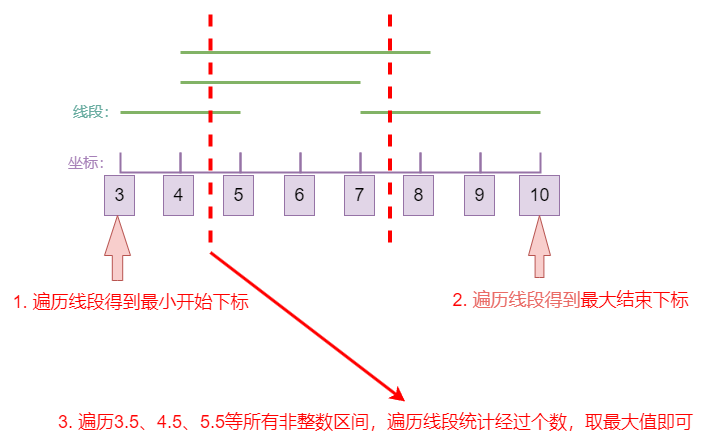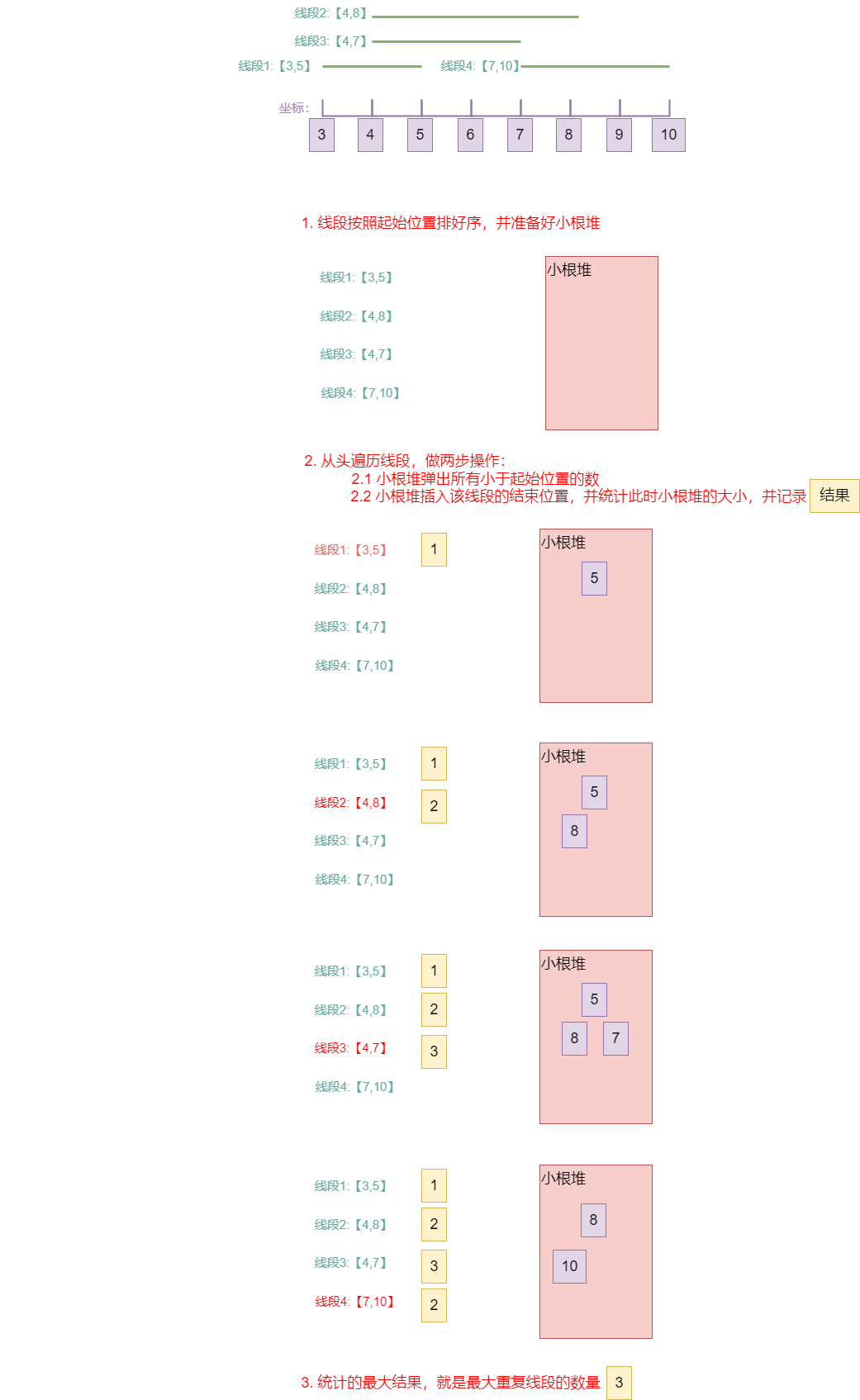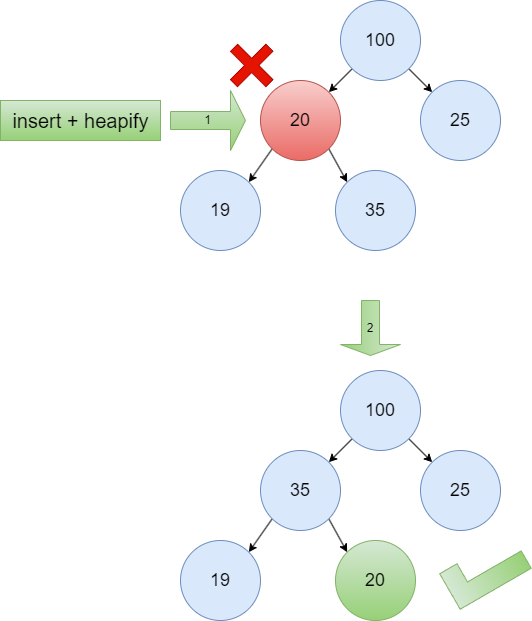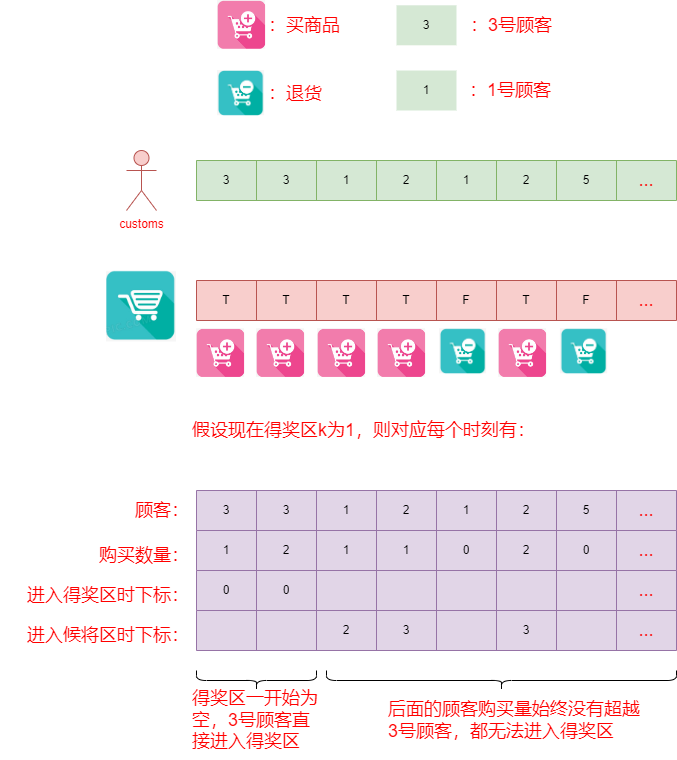# 加强堆
# 最大线段重合问题
题目:
给定很多线段, 每个线段都有两个数[start, end] ,表示线段开始位置和结束位置,左右都是闭区间
规定:
- 线段的开始和结束位置一定都是整数值
- 线段重合区域的长度必须 >=1
返回线段最多重合区域(点重合不算)中,包含了几条线段?
# 简单方法:

- 通过遍历所有的线段得到所有的线段所在的区间
- 线段开始与结束都为整数,所以在小数的位置如果重合,则线段一定重合,整数区间可能只是点重合
- 在每一个非整数区间遍历所有线段,统计经过该区间的所有线段
- 取区间上的最大值,即可得出结果
# 堆解决:

# 代码实现
package heap_trianning
import (
"traning/algorithm/utility"
"traning/algorithm/utility/heap02"
)
// 1. 暴力解法
func GetMaxRepeatLineNum(lines [][]int) int {
min, max := 0, 0
for _, line := range lines {
min = utility.Min(line[0], min)
max = utility.Max(line[0], max)
}
var ans int
for i:=min; i<max; i++ {
sag := float64(i) + 0.5
curRepeat := 0
for _, line := range lines {
if float64(line[0]) < sag && sag < float64(line[1]) {
curRepeat++
}
}
ans = utility.Max(ans, curRepeat)
}
return ans
}
// 2. 使用堆
func GetMaxRepeatLineNum2(lines [][]int) int {
myLines := SortableLines(lines)
hp := heap02.NewHeap(len(lines), func (a interface{}, b interface{}) bool { // 小根堆,自定义比较器
return a.(int) < b.(int)
})
var ans int
for _, line := range myLines {
for hp.Peek() != nil && hp.Peek().(int) < line[0] {
hp.Poll()
}
hp.Add(line[1])
ans = utility.Max(ans, hp.Size())
}
return ans
}
type SortableLines [][]int
func (s SortableLines) Len() int {
return len(s)
}
func (s SortableLines) Less(i, j int) bool {
return s[i][0] < s[j][0]
}
func (s SortableLines) Swap(i, j int) {
s[i], s[j] = s[j], s[i]
}
2
3
4
5
6
7
8
9
10
11
12
13
14
15
16
17
18
19
20
21
22
23
24
25
26
27
28
29
30
31
32
33
34
35
36
37
38
39
40
41
42
43
44
45
46
47
48
49
50
51
52
53
54
55
56
57
58
59
60
自定义堆实现
package heap02
func NewHeap(cap int, compare func(interface{}, interface{}) bool) MyHeap {
return MyHeap{
cap: cap,
compare: compare,
nodes: make([]interface{}, cap),
size: 0,
}
}
type MyHeap struct {
cap int
size int
nodes []interface{}
compare func(interface{}, interface{}) bool
}
func (mH *MyHeap) Size() int {
return mH.size
}
func (mH *MyHeap)Add(node interface{}) {
if mH.size == mH.cap {
panic(any("heap is full"))
}
mH.nodes[mH.size] = node
mH.Insert(mH.size)
mH.size++
}
func (mH *MyHeap)Insert(index int) {
cur := index
parent := (cur-1) >> 1
for cur > 0 {
if mH.compare(mH.nodes[cur], mH.nodes[parent]) {
mH.Swap(cur, parent)
} else {
break
}
cur = parent
parent = (cur-1) >> 1
}
}
func (mH *MyHeap) Poll() interface{} {
if mH.size == 0 {
panic(any("heap is empty"))
}
ans := mH.nodes[0]
mH.size--
mH.Swap(0, mH.size)
mH.heapify(0)
return ans
}
func (mH *MyHeap) heapify(index int) {
cur := index
next := (cur<<1) | 1
for next < mH.size {
if next+1 < mH.size && !mH.compare(mH.nodes[next], mH.nodes[next+1]) {
next = next +1
}
if !mH.compare(mH.nodes[cur], mH.nodes[next]) {
mH.Swap(cur, next)
} else {
break
}
cur = next
next = (cur<<1) | 1
}
}
func (mH *MyHeap)Peek() interface{} {
if mH.size == 0 {
return nil
}
return mH.nodes[0]
}
func (mH *MyHeap)Swap(index1, index2 int) {
mH.nodes[index1], mH.nodes[index2] = mH.nodes[index2], mH.nodes[index1]
}
2
3
4
5
6
7
8
9
10
11
12
13
14
15
16
17
18
19
20
21
22
23
24
25
26
27
28
29
30
31
32
33
34
35
36
37
38
39
40
41
42
43
44
45
46
47
48
49
50
51
52
53
54
55
56
57
58
59
60
61
62
63
64
65
66
67
68
69
70
71
72
73
74
75
76
77
78
79
80
81
82
83
# 加强堆
加强堆是一种特殊而强大的数据结构,它在普通堆的基础上进行了进一步的增强,为某些特殊场景提供了更高效的解决方案。
这种加强常常涉及到对普通堆的扩展,可能引入一些额外的数据结构或算法来达到更优的性能。加强堆的设计灵感往往来自于实际应用中对于特定操作的需求,力求在保持堆的基本特性的同时,提供更多功能和更高的效率。🚀✨
下面讲解一种堆,其中仅有一个元素不对的情况下,可以调整该元素并恢复的堆结构:

对于在一个正常堆结构中,仅有一个元素位置不对的时候,我们只需要执行:
heapifyinsert
两个操作不分先后,因为只会走其中的一种,且复杂度只有O(logN)
# 加强堆实现
package heap02
func NewHeapGreater(cap int, compare func(interface{}, interface{}) bool) HeapGreater {
return HeapGreater{
cap: cap,
compare: compare,
nodes: make([]interface{}, cap),
nodesIndexMap: make(map[interface{}]int),
size: 0,
}
}
type HeapGreater struct {
cap int
size int
nodes []interface{}
compare func(interface{}, interface{}) bool
nodesIndexMap map[interface{}]int
}
func (hg *HeapGreater)Add(node interface{}) {
if hg.size == hg.cap {
panic(any("heap is full"))
}
hg.nodes[hg.size] = node
hg.nodesIndexMap[node] = hg.size
hg.insert(hg.size)
hg.size++
}
func (hg *HeapGreater) Poll() interface{} {
if hg.size == 0 {
panic(any("heap is empty"))
}
ans := hg.nodes[0]
hg.size--
hg.Swap(0, hg.size)
hg.heapify(0)
delete(hg.nodesIndexMap, ans)
return ans
}
func (hg *HeapGreater) Resign(node interface{}) {
hg.heapify(hg.nodesIndexMap[node])
hg.insert(hg.nodesIndexMap[node])
}
func (hg *HeapGreater) Remove(node interface{}) {
replace := hg.nodes[hg.size-1]
index := hg.nodesIndexMap[node]
delete(hg.nodesIndexMap, node)
hg.size--
if replace != node { // swap不能用,因为resign 依赖size与mapindex
hg.nodes[index] = replace
hg.nodesIndexMap[replace] = index
hg.Resign(replace)
}
}
func (hg *HeapGreater) GetAllElements() []interface{} {
ans := make([]interface{}, hg.size)
copy(ans, hg.nodes)
return ans
}
func (hg *HeapGreater)Peek() interface{} {
if hg.size == 0 {
return nil
}
return hg.nodes[0]
}
func (hg *HeapGreater) Size() int {
return hg.size
}
func (hg *HeapGreater) Empty() bool {
return hg.size == 0
}
func (hg *HeapGreater) Contain(node interface{}) bool {
_, ok := hg.nodesIndexMap[node]
return ok
}
func (hg *HeapGreater) insert(index int) {
for hg.compare(hg.nodes[index], hg.nodes[(index-1) / 2]) {
hg.Swap(index, (index-1) / 2)
index = (index-1) / 2
}
}
func (hg *HeapGreater) heapify(index int) {
cur := index
next := (cur<<1) | 1
for next < hg.size {
if next+1 < hg.size && !hg.compare(hg.nodes[next], hg.nodes[next+1]) {
next = next +1
}
if !hg.compare(hg.nodes[cur], hg.nodes[next]) {
hg.Swap(cur, next)
} else {
break
}
cur = next
next = (cur<<1) | 1
}
}
func (hg *HeapGreater)Swap(index1, index2 int) {
node1, node2 := hg.nodes[index1], hg.nodes[index2]
hg.nodesIndexMap[node1], hg.nodesIndexMap[node2] = hg.nodesIndexMap[node2], hg.nodesIndexMap[node1]
hg.nodes[index1], hg.nodes[index2] = hg.nodes[index2], hg.nodes[index1]
}
package heap02
func NewHeapGreater(cap int, compare func(interface{}, interface{}) bool) HeapGreater {
return HeapGreater{
cap: cap,
compare: compare,
nodes: make([]interface{}, cap),
nodesIndexMap: make(map[interface{}]int), // 记录加入堆node的在nodes中的位置index
size: 0,
}
}
type HeapGreater struct {
cap int
size int
nodes []interface{}
compare func(interface{}, interface{}) bool
nodesIndexMap map[interface{}]int
}
func (hg *HeapGreater)Add(node interface{}) {
if hg.size == hg.cap {
panic(any("heap is full"))
}
hg.nodes[hg.size] = node
hg.nodesIndexMap[node] = hg.size // 添加节点的时候记录位置
hg.insert(hg.size)
hg.size++
}
func (hg *HeapGreater) Poll() interface{} {
if hg.size == 0 {
panic(any("heap is empty"))
}
ans := hg.nodes[0]
hg.size--
hg.Swap(0, hg.size)
hg.heapify(0)
delete(hg.nodesIndexMap, ans) // 取出节点的时候删除位置信息
return ans
}
func (hg *HeapGreater) Resign(node interface{}) { // 重新调整节点位置,做一次heapify和insert即可
hg.heapify(hg.nodesIndexMap[node])
hg.insert(hg.nodesIndexMap[node])
}
func (hg *HeapGreater) Remove(node interface{}) { // 移除指定节点
replace := hg.nodes[hg.size-1] // 获取堆最后一个元素用来取代当前要移除的节点
index := hg.nodesIndexMap[node] // 获取需要移除的节点的 index 索引信息
delete(hg.nodesIndexMap, node) // 删除需要移除的节点的 index 索引信息
hg.size-- // 删除需要替换的元素
if replace != node { // 如果替换的节点就是需要删除的节点直接结束
hg.nodes[index] = replace // 用于替换的节点放入删除节点的位置
hg.nodesIndexMap[replace] = index // 更新替换节点的位置信息
hg.Resign(replace) // 调整替换节点的位置
}
}
func (hg *HeapGreater) GetAllElements() []interface{} { // 方便获取所有的堆元素
ans := make([]interface{}, hg.size)
copy(ans, hg.nodes)
return ans
}
func (hg *HeapGreater)Peek() interface{} { // 查看堆顶的元素
if hg.size == 0 {
return nil
}
return hg.nodes[0]
}
func (hg *HeapGreater) Size() int {
return hg.size
}
func (hg *HeapGreater) Empty() bool {
return hg.size == 0
}
func (hg *HeapGreater) Contain(node interface{}) bool {
_, ok := hg.nodesIndexMap[node]
return ok
}
func (hg *HeapGreater) insert(index int) {
for hg.compare(hg.nodes[index], hg.nodes[(index-1) / 2]) {
hg.Swap(index, (index-1) / 2)
index = (index-1) / 2
}
}
func (hg *HeapGreater) heapify(index int) {
cur := index
next := (cur<<1) | 1
for next < hg.size {
if next+1 < hg.size && !hg.compare(hg.nodes[next], hg.nodes[next+1]) {
next = next +1
}
if !hg.compare(hg.nodes[cur], hg.nodes[next]) {
hg.Swap(cur, next)
} else {
break
}
cur = next
next = (cur<<1) | 1
}
}
func (hg *HeapGreater)Swap(index1, index2 int) {
node1, node2 := hg.nodes[index1], hg.nodes[index2]
hg.nodesIndexMap[node1], hg.nodesIndexMap[node2] = hg.nodesIndexMap[node2], hg.nodesIndexMap[node1]
hg.nodes[index1], hg.nodes[index2] = hg.nodes[index2], hg.nodes[index1]
}
2
3
4
5
6
7
8
9
10
11
12
13
14
15
16
17
18
19
20
21
22
23
24
25
26
27
28
29
30
31
32
33
34
35
36
37
38
39
40
41
42
43
44
45
46
47
48
49
50
51
52
53
54
55
56
57
58
59
60
61
62
63
64
65
66
67
68
69
70
71
72
73
74
75
76
77
78
79
80
81
82
83
84
85
86
87
88
89
90
91
92
93
94
95
96
97
98
99
100
101
102
103
104
105
106
107
108
109
110
111
112
113
114
115
116
117
118
119
120
121
122
123
124
125
126
127
128
129
130
131
132
133
134
135
136
137
138
139
140
141
142
143
144
145
146
147
148
149
150
151
152
153
154
155
156
157
158
159
160
161
162
163
164
165
166
167
168
169
170
171
172
173
174
175
176
177
178
179
180
181
182
183
184
185
186
187
188
189
190
191
192
193
194
195
196
197
198
199
200
201
202
203
204
205
206
207
208
209
210
211
212
213
214
215
216
217
218
219
220
221
222
223
224
225
226
227
228
229
230
简单验证
package heap02
import (
"fmt"
"testing"
)
func TestNewHeapGreater(t *testing.T) {
type Customer struct {
Id int
buy int
changeTime int
}
// 初始化小根堆
mgh := NewHeapGreater(10, func(c1 interface{}, c2 interface{}) bool {
cus1, cus2 := c1.(*Customer), c2.(*Customer) // 需要传入结构体指针,配合使用
if cus1.buy != cus2.buy {
return cus1.buy < cus2.buy
}
return cus1.changeTime < cus1.changeTime
})
cusNum := 10
cuses := make([]*Customer, cusNum)
for i:=cusNum; i>0; i-- { // 倒序加入元素
cuses[i-1] = &Customer{
Id: i,
buy: i,
changeTime: i,
}
mgh.Add(cuses[i-1])
}
for _, addr := range mgh.GetAllElements() {
fmt.Printf("%+v ", addr.(*Customer).buy)
// 1
// 2 5(将变->20)
// 4 3 9 6
// 10 7 8
}
fmt.Println("/n---------")
cuses[4].buy = 20
mgh.Resign(cuses[4])
// 打印结构体列表的内容
for _, addr := range mgh.GetAllElements() {
fmt.Printf("%+v ", addr.(*Customer).buy)
// 1 2 6 4 3 9 20 10 7 8
// 1
// 2 6
// 4 3 9 20(5->20并调整对了位置)
// 10 7 8
}
fmt.Println("/n---------")
mgh.Remove(cuses[3])
for _, addr := range mgh.GetAllElements() {
fmt.Printf("%+v ", addr.(*Customer).buy)
}
fmt.Println("/n---------")
// &buy:1,buy:2,buy:6,buy:4,buy:3,buy:9,buy:20,buy:10,buy:7,buy:8
for mgh.size > 0 {
fmt.Println(mgh.Poll())
}
}
2
3
4
5
6
7
8
9
10
11
12
13
14
15
16
17
18
19
20
21
22
23
24
25
26
27
28
29
30
31
32
33
34
35
36
37
38
39
40
41
42
43
44
45
46
47
48
49
50
51
52
53
54
55
56
57
58
59
60
61
# 买卖商品

给定一个整型数组, []int arr; 和一个布尔类型数组, []boolean op 两个数组一定等长, 假设长度为N, arr门表示客户编号, op门表示客户操作 arr=[3, 3, 1, 2,1,2,5… op=[T, T, T, T, F, T, F… 依次表示:3用户购买了一件商品,3用户购买了一件商品,1用户购买了一件 商品,2用户购买了一件商品,1用户退货了一件商品,2用户购买了一件商品, 5用户退货了一件商品…
得奖系统的规则:
如果某个用户购买商品数为0.但是又发生了退货事件,则认为该事件无效,得奖名单和之前事件时一致,比如例子中的5用户
某用户发生购买商品事件,购买商品数+1.发生退货事件,购买商品数-1
每次都是最多K个用户得奖,K也为传入的参数,如果根据全部规则,得奖人数确实不够K个,那就以不够的情况输出结果
得奖系统分为得奖区和候选区,任何用户只要购买数>0,一定在这两个区域中的一个
购买数最大的前K名用户进入得奖区,在最初时如果得奖区没有到达K个用户,那么新来的用户直接进入得奖区
如果购买数不足以进入得奖区的用户,进入候选区
如果候选区购买数最多的用户,已经足以进入得奖区,
该用户就会替换得奖区中购买数最少的用户(大于才能替换),
如果得奖区中购买数最少的用户有多个,就替换最早进入得奖区的用户
如果候选区中购买数最多的用户有多个,机会会给最早进入候选区的用户
候选区和得奖区是两套时间,
因用户只会在其中一个区域,所以只会有一个区域的时间,另一个没有
从得奖区出来进入候选区的用户,得奖区时间删除,
进入候选区的时间就是当前事件的时间(可以理解为arr[和op门中的i)
从候选区出来进入得奖区的用户,候选区时间删除,
进入得奖区的时间就是当前事件的时间(可以理解为arr[和op[] 中的i)
如果某用户购买数==0,不管在哪个区域都离开,区域时间删除,
离开是指彻底离开,哪个区域也不会找到该用户
如果下次该用户又发生购买行为,产生>0的购买数,
会再次根据之前规则回到某个区域中,进入区域的时间重记
要求得到任何下标时,得奖区的客户,格式为:
[
[3], // 0 时刻
[3], // 1 时刻
...
]
2
3
4
5
# 题解
🌱题解源码仓储对应目录🌱 (opens new window)
暴力解法
package heap_trianning
import (
"sort"
)
type Customer struct {
ID int
Buy int
Time int
}
type Daddys []*Customer
type Cands []*Customer
func GetTopKCustomers(customers []int, operate []bool, K int) [][]int {
customersMap := map[int]*Customer{} // 记录客户是否已经买过东西
daddys := make(Daddys, 0) // 得奖区的客户
cands := make(Cands, 0) // 候奖区的客户
ans := make([][]int, 0) // 初始化结果
for i, c := range customers {
if _, ok := customersMap[c]; !ok && !operate[i] { // 不存在该客户且退货的,直接跳过
ans = append(ans, daddys.GetCustomers())
continue
}
// 获取到当前的顾客,没有的话初始化一个顾客
var curC *Customer
if cc, ok := customersMap[c]; ok {
curC = cc
} else {
curC = &Customer{ID: c}
customersMap[c] = curC
}
if operate[i] { // 如果当前是买操作
curC.Buy++
} else {
curC.Buy--
}
if curC.Buy == 0 { // 如果此时顾客买的数量为0,情况顾客的map
delete(customersMap, curC.ID)
}
// 将当前顾客不在得奖区与候奖区的情况排除
if !daddys.Contain(curC) && !cands.Contain(curC) {
if len(daddys) < K {
curC.Time = i // 赋值进入得奖区的时间
daddys = append(daddys, curC)
} else {
curC.Time = i
cands = append(cands, curC)
}
}
daddys.CleanZeroBuy() // 清除得奖区里退货变成0购买的
cands.CleanZeroBuy() // 清除候奖区里退货变成0购买的
sort.Sort(cands) // 得奖区重新调整顺序
sort.Sort(daddys) // 得奖区重新调整顺序
move(&daddys, &cands, K, i) // 如果候奖区与得奖区需要替换,则需要移动元素
ans = append(ans, daddys.GetCustomers()) // 重新获取得奖区的顾客
}
return ans
}
func move(daddys *Daddys, cands *Cands, K int, time int) {
if len(*cands) == 0 { // 候选区为空,不需要移动
return
}
if len(*daddys) < K { // 得奖区没满的情况,一定是候选区有,但是得奖区其中有一个顾客退货
(*cands)[0].Time = time
*daddys = append(*daddys, (*cands)[0])
*cands = (*cands)[1:]
} else { // 得奖区满了,且候奖区有客户的情况,如果候奖区的顾客最大的购买量超过得奖区的顾客,则发生移动
if (*cands)[0].Buy > (*daddys)[0].Buy { // 侯奖区与得奖区客户发生交换
oldDaddy := (*daddys)[0]
newDaddy := (*cands)[0]
oldDaddy.Time = time
newDaddy.Time = time
(*daddys)[0], (*cands)[0] = (*cands)[0], (*daddys)[0]
}
}
}
func (d Daddys) Len() int {
return len(d)
}
func (d Daddys) Less(i, j int) bool {
if d[i].Buy != d[j].Buy {
return d[i].Buy < d[j].Buy
}
return d[i].Time < d[j].Time
}
func (d Daddys) Swap(i, j int) {
d[i], d[j] = d[j], d[i]
}
func (d *Daddys) Contain(cc *Customer) bool {
var ans bool
for _, dc := range *d {
if dc == cc {
ans = true
}
}
return ans
}
func (d *Daddys) CleanZeroBuy() {
var newD Daddys
for _, dc := range *d {
if dc.Buy != 0 {
newD = append(newD, dc)
}
}
*d = newD
}
func (d *Daddys) GetCustomers() []int {
var customers []int
for _, dc := range *d {
customers = append(customers, dc.ID)
}
return customers
}
func (c Cands) Len() int {
return len(c)
}
func (c Cands) Less(i, j int) bool {
if c[i].Buy != c[j].Buy {
return c[i].Buy > c[j].Buy
}
return c[i].Time < c[j].Time
}
func (c Cands) Swap(i, j int) {
c[i], c[j] = c[j], c[i]
}
func (c *Cands) Contain(cc *Customer) bool {
var ans bool
for _, candc := range *c {
if candc == cc {
ans = true
}
}
return ans
}
func (c *Cands) CleanZeroBuy() {
var newD Cands
for _, dc := range *c {
if dc.Buy != 0 {
newD = append(newD, dc)
}
}
*c = newD
}
func (c *Cands) GetCustomers() []int {
var customers []int
for _, dc := range *c {
customers = append(customers, dc.ID)
}
return customers
}
2
3
4
5
6
7
8
9
10
11
12
13
14
15
16
17
18
19
20
21
22
23
24
25
26
27
28
29
30
31
32
33
34
35
36
37
38
39
40
41
42
43
44
45
46
47
48
49
50
51
52
53
54
55
56
57
58
59
60
61
62
63
64
65
66
67
68
69
70
71
72
73
74
75
76
77
78
79
80
81
82
83
84
85
86
87
88
89
90
91
92
93
94
95
96
97
98
99
100
101
102
103
104
105
106
107
108
109
110
111
112
113
114
115
116
117
118
119
120
121
122
123
124
125
126
127
128
129
130
131
132
133
134
135
136
137
138
139
140
141
142
143
144
145
146
147
148
149
150
151
152
153
154
155
156
157
158
159
160
161
162
163
164
使用加强堆
package heap_trianning
import (
"traning/algorithm/utility/heap02"
)
func GetTopKCustomersWithGreaterHeap(customers []int, operate []bool, K int) [][]int {
ans := make([][]int, 0)
if K == 0 {
return ans
}
customersMap := make(map[int]*Customer)
daddys := heap02.NewHeapGreater(K, func(c1, c2 interface{}) bool { // 初始化得奖区的加强堆
customer1, customer2 := c1.(*Customer), c2.(*Customer)
if customer1.Buy != customer2.Buy {
return customer1.Buy < customer2.Buy
}
return customer1.Time < customer2.Time
})
cands := heap02.NewHeapGreater(len(customers), func(c1, c2 interface{}) bool { // 初始化得奖区的加强堆
customer1, customer2 := c1.(*Customer), c2.(*Customer)
if customer1.Buy != customer2.Buy {
return customer1.Buy > customer2.Buy
}
return customer1.Time < customer2.Time
})
for time, customerId := range customers {
if _, ok := customersMap[customerId]; !ok && !operate[time] {
// 不存在的顾客且发生退货,则直接获取上一次的获奖人,并继续
ans = append(ans, ToCustomerIds(daddys.GetAllElements()))
continue
}
var curCustomer *Customer
if c, ok := customersMap[customerId]; !ok {
curCustomer = &Customer{
ID: customerId,
}
customersMap[customerId] = curCustomer
} else {
curCustomer = c
}
if operate[time] {
curCustomer.Buy++
} else {
curCustomer.Buy--
}
// 清空 customersMap 如果现在顾客的购买量为 0 需要清除
if curCustomer.Buy == 0 {
delete(customersMap, curCustomer.ID)
}
// 将新客户加入候将区或得奖区
if !daddys.Contain(curCustomer) && !cands.Contain(curCustomer) {
if daddys.Size() < K {
curCustomer.Time = time
daddys.Add(curCustomer)
} else {
curCustomer.Time = time
cands.Add(curCustomer)
}
}
// 此时顾客一定在两个区中且购买量为0,则需要清除
if daddys.Contain(curCustomer) && curCustomer.Buy == 0 {
daddys.Remove(curCustomer)
}
if cands.Contain(curCustomer) && curCustomer.Buy == 0 {
cands.Remove(curCustomer)
}
// 元素发生变更需要维护堆
if daddys.Contain(curCustomer) {
daddys.Resign(curCustomer)
}
if cands.Contain(curCustomer) {
cands.Resign(curCustomer)
}
moveGreaterHeap(&daddys, &cands, time, K)
ans = append(ans, ToCustomerIds(daddys.GetAllElements()))
}
return ans
}
func moveGreaterHeap(daddys, cands *heap02.HeapGreater, time, K int) {
if cands.Size() == 0 {
return
}
if daddys.Size() < K { // 得奖区有客户退出
newDaddy := cands.Peek().(*Customer)
cands.Remove(newDaddy)
newDaddy.Time = time
daddys.Add(newDaddy)
} else {
if cands.Peek().(*Customer).Buy > daddys.Peek().(*Customer).Buy {
newDaddy := cands.Peek().(*Customer)
oldDaddy := daddys.Peek().(*Customer)
cands.Remove(newDaddy)
daddys.Remove(oldDaddy)
newDaddy.Time = time
oldDaddy.Time = time
cands.Add(oldDaddy)
daddys.Add(newDaddy)
}
}
}
func ToCustomerIds(daddys []interface{}) []int {
var daddyIds []int
for _, c := range daddys {
daddyIds = append(daddyIds, c.(*Customer).ID)
}
return daddyIds
}
2
3
4
5
6
7
8
9
10
11
12
13
14
15
16
17
18
19
20
21
22
23
24
25
26
27
28
29
30
31
32
33
34
35
36
37
38
39
40
41
42
43
44
45
46
47
48
49
50
51
52
53
54
55
56
57
58
59
60
61
62
63
64
65
66
67
68
69
70
71
72
73
74
75
76
77
78
79
80
81
82
83
84
85
86
87
88
89
90
91
92
93
94
95
96
97
98
99
100
101
102
103
104
105
106
107
108
109
110
测试代码
package heap_trianning
import (
"fmt"
"testing"
"traning/algorithm/utility"
)
func TestCleanZeroBuy(t *testing.T) {
var daddys Daddys
daddys = append(daddys, &Customer{
Buy: 1,
})
daddys.CleanZeroBuy()
fmt.Println(daddys)
}
// 调试暴力方法
func TestGetTopKCustomers(t *testing.T) {
fmt.Println(GetTopKCustomers(
[]int{3,1,1,1,1,2,2},
[]bool{true, true, true, false, false, true, true},
1,
))
}
// 调试加强堆方法
func TestGetTopKCustomersWithGreaterHeap(t *testing.T) {
fmt.Println(GetTopKCustomersWithGreaterHeap(
[]int{1 ,2 ,0 , 4 ,3 , 4},
[]bool{false, true, true, true ,false ,true},
2,
))
}
// 大数据量对比测试
func TestGetTopKCustomersWithGreaterHeapOK(t *testing.T) {
//a := assert.New(t)
testTime := 5000 // 测试次数
testArrMaxLen := 1000 // 随机数组的最大长度[0, testArrMaxLen)
testArrMaxNum := 15 // 随机数组中最大的数字[0, testArrMaxNum)
testMaxK := 3 // 最大获奖人数
randomCreator := utility.GetRandomNumCreator() // 初始化随机数组生成器
for i:=0; i<testTime; i++ { // 开始测试,总共测试50万次
// 生成一个 长度为 [0, testArrMaxLen) 数字大小为 [0, testArrMaxNum) 的随机数组
customers := randomCreator.GetRandomArr(testArrMaxNum, testArrMaxLen)
operates := randomCreator.GetRandomBool(len(customers))
K := randomCreator.GetRandom(testMaxK)
// 拷贝数组用于进行校验
ans1 := GetTopKCustomers(customers, operates, K)
ans2 := GetTopKCustomersWithGreaterHeap(customers, operates, K)
if !utility.ArrSetEqual(ans1, ans2) {
fmt.Println("ans1", ans1)
fmt.Println("ans2", ans2)
fmt.Println("customers ", customers)
fmt.Println("operates ", operates)
panic(any("ans no equal !!!"))
}
}
}
2
3
4
5
6
7
8
9
10
11
12
13
14
15
16
17
18
19
20
21
22
23
24
25
26
27
28
29
30
31
32
33
34
35
36
37
38
39
40
41
42
43
44
45
46
47
48
49
50
51
52
53
54
55
56
57
58
59
60